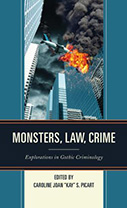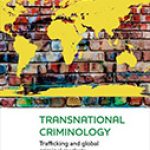Monsters, Law, Crime: Explorations in Gothic Criminology

Editor: Caroline Joan “Kay” S. Picart
Publisher: Fairleigh Dickinson University Press, 2021
Reviewer: Jeffrey A. Tolbert ǀ June 2022
Monsters, Law, Crime sets out to explore “gothic criminology,” a term coined in an earlier work by editor Picart to refer to specific rhetorical and aesthetic parallels between popular media and scholarly representations of crimes and the people who commit them. Specifically, gothic criminology points to the tendency to make monsters out of criminals.
This volume draws together contributions from scholars and practitioners in a range of fields, including law, communication studies, anthropology, literary studies, sociology, criminology, and others. The chapters are widely divergent in terms of both their theoretical frameworks and the methodologies their authors employ. Anthropologist John Morton takes a psychoanalytic approach to Australian Aboriginal culture, while Lucy Williams, Sandra Walktale, and Barry Godfrey read the “monstrous” from Victorian news accounts of inmates at Broadmoor Hospital (according to the authors, Britain’s first “Criminal Lunatic Asylum”). Orit Kamir explores a cultural and media frenzy surrounding a 38-year-old Israeli woman accused of sexually assaulting hundreds of boys. Steve Greenfield examines cinematic depictions of real-life serial killer doctors, contrasting the “monstrous” portrayal of Marcel Pétiot with the relative everyday-ness of Harold Shipman.
In a chapter that should be of special interest to contemporary anthropologists, folklorists, and others, criminologist John Frauley traces the “teratological lineage” of modern criminology, centered on the work of founding figure Cesare Lombroso. Frauley argues that “[Lombroso’s] criminal anthropology was concerned with the clinical monsters of medicine and that criminology emerged from the nineteenth century as a science of monster detection” (41). He explores Lombroso’s development of the concept of atavism and traces its movements between science and literature in the 19th century. As he does so, he lays an important foundation for scholars interested in such contemporary phenomena as the increasingly popular “folk horror” subgenre of horror fiction, which makes frequent use of the notion of atavism in its more colloquial sense of an irruption of a suppressed past into the present, even as horror in general continues to rely on atavism in the more literal (i.e., physiological/behavioral) sense proposed by Lombroso.
Not every chapter is as able to foreground the monstrous as Frauley’s; in a few cases, contributions are connected to the volume’s primary theme (the monstrous) by the thinnest of metaphorical threads. Yet in a general sense, the idea of reading the monstrous from popular discourse and scholarly/legal practice, of course remains a valuable one. In his postscript to the collection, Cecil Greek likens Donald Trump first to DC Comic’s Batman (Lex Luthor would have been a more apt comparison) and then to Marvel’s supervillain, Thanos. (He stops short of asking how Trump’s own rhetoric created monsters, or how a significant portion of the American public came to accept Trump’s monstrosity.) Recognizing our own conceptions of monsters in contemporary sociopolitical life—and especially the hegemonic deployment and weaponization of monstrosity—continues to be a critical first step in the fight against the contemporary evils of nationalism, racism, and all the other ways humans devise to oppress one another.
Jeffrey A. Tolbert, Penn State University, Harrisburg


